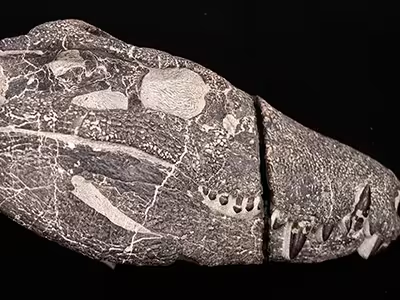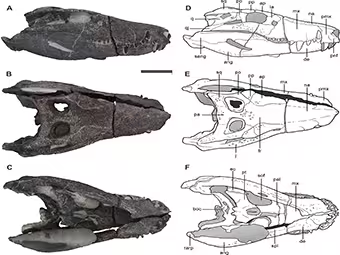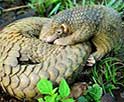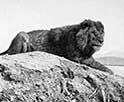New Prehistoric Crocodile Species Discovered in Patagonia
The Kostensuchus atrox: An Ancient Crocodilian Predator from Patagonia
Reading time : 1 minute,
Discovery Chepe Id-799-ECO
Published in
08-29-2025

Photo: National Geographic José Brusco . Silent witness to bygone eras. This is the skull of Kostensuchus atrox, a Patagonian hypercarnivore from the Cretaceous period, a discovery that connects us to the distant prehistory.
In a remarkable paleontological expedition near El Calafate in Santa Cruz province, southern Patagonia, Argentine, Brazilian, and Japanese scientists uncovered the remains of a new prehistoric crocodile species. Their findings were recently published in the journal PLOS One.
Name and meaning
The species was named Kostensuchus atrox. -Kosten- honors the Patagonian wind (in the Tehuelche language), while -suchus- refers to the crocodile-headed Egyptian god. -Atrox- means -fierce- in Latin, underscoring its predatory nature.
Physical traits and lifestyle
Measuring about 3.5 meters long and weighing roughly 250 kg, this hypercarnivore consumed over 70 % meat. Its robust skull, broad snout, large teeth, and powerful limbs suggest it was an active land predator, unlike today's crocodilians.

70-Million-Year-Old Crocodile Fossil Found in Santa Cruz, Patagonia
Photo: Journal Pone, Fernando E. NovasDiego Pol, Marcelo P. Isasi.
Environment and ecosystem
Discovered in the Chorrillo Formation, this freshwater floodplain existed some 70 million years ago in southern Patagonia, under a warm and humid climate?vastly different from today?s cold conditions. Kostensuchus coexisted with herbivorous dinosaurs like Isasicursor, turtles, early mammals, frogs, and insects.
Scientific significance
This specimen is among the most complete peirosaurids ever discovered and the first of its kind found in the Chorrillo Formation. It enriches our understanding of terrestrial crocodyliform diversity during the dinosaur era and strengthens the evolutionary link between South America and Africa, formed during Gondwana's existence.
From expedition to publication
Unearthed during a 2020 dig in Estancia Anita (about 30 km southwest of El Calafate), the fossil underwent painstaking lab preparation before its formal classification as a new genus and species.
This discovery deepens our narrative of late Cretaceous Patagonia and prompts a thrilling question: what other lost species remain hidden beneath its ancient sediments?
See Also
Discovery Chepe
Most read...















